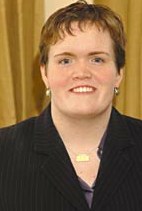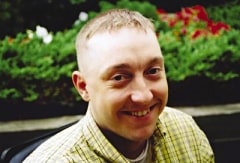
By Kelly Mack
The next generation isn’t just a Star Trek television series–it’s our future taking shape right now. New leaders with disabilities are engaged and active citizens of the world. They are traveling internationally, starting nonprofit organizations, earning graduate degrees, organizing protests, getting into business and paving the way for exciting developments for people with disabilities. These energetic youths, spurred on by examples set by established and experienced leaders with disabilities, are pushing activism to the next level. They are benefiting from improved educational opportunities and accessibility–the fruit of hard-earned victories of previous advocates. With spunk, intelligence and determination, they continue the battle for equality.
While these four are but a glimpse into the many young people active in local and national communities, this sample offers a chance to appreciate the accomplishments, present and in progress, of today’s young leaders. With many different perspectives on leadership and methods of tackling advocacy, what unites these individuals is the passion to pursue their personal dreams and community commitments.
Cheri Blauwet

Cheri Blauwet is a little busy. Between competing in wheelchair marathons, attending medical school at Stanford University and launching the nonprofit International Institute for Disability Advocacy, she doesn’t have much time for boredom. At age 23, Blauwet has lived with a spinal cord injury for almost her entire life. “Because I was injured when I was so young, I grew up feeling completely comfortable about my disability and learned how to accommodate different situations as they arose.” Blauwet is the recipient of a 2004 Paul G. Hearne Award, having been recognized for her leadership on disability issues by the American Association of People with Disabilities.
Blauwet believes strongly in confronting cultural and physical limitations set by inaccessible environments and living up to her own expectations. “I believe that I can show young people that your disability does not have to define your role in society. Only you can set expectations for yourself, and you shouldn’t let other people’s expectations cast you into a role that doesn’t excite you.” Blauwet is determined not to let others distract her from her goals “by showing people that I can do what they do and more, even though I do it from a chair. I never for one moment let using a wheelchair make my expectations for myself lower.”
In the future, Blauwet sees opportunities for youth leaders with disabilities to change societal perceptions so that people understand that disability does not mean the same thing as inability. One of the next challenges is to educate and empower leaders with disabilities around the world and in less developed countries so that the message can go global–along with more opportunities for people with disabilities. She inhabits this message with her athletic successes, earning medals in Sydney at the 2000 Paralympics and winning the Los Angeles, Boston and New York marathons in the wheelchair category. Blauwet also plans to put a medical degree to work in international health and disability rights.
Joannah Peterson

Nineteen ninety-two was a year of change for Joannah Peterson. At age 14 she was injured in a car accident, resulting in a spinal cord injury and paralysis from the waist down. When she entered rehab in Atlanta, she believed she was about to learn how to walk again. “I didn’t have any significant recovery from my injury, but I learned how to do a lot of other things. And I learned a lot of other things that I never thought I would be able to do.” In adjusting to her paralysis, Peterson discovered that “basically anything I want to do, I can do it, just in a different way.”
Now 26 years old, Peterson studies Japanese at the University of Indiana. Several years ago Peterson applied for the Japanese Exchange Teaching Program, becoming the first person in a wheelchair sent to Japan on the program. “In my essay I said that I could teach them more than English. I could teach them that no matter what they want to do, they can do it,” says Peterson.
Peterson doesn’t dwell on her disability as a limiting difference. “Sometimes I’m aware of it because people treat you differently. They think that you can’t do things–they underestimate you in some ways. I think that the best way to deal with that is to become friends with people.” And she witnessed this first-hand when teaching in Japan, where she observed how her students’ attitudes about disability changed as they came to know her.
Accessibility challenges were frequent in Japan because even though all new buildings are required by law to be made accessible, older buildings do not have to be retrofitted for wheelchair accessibility. “It’s more difficult to get around there. And I think that comes into play really harshly with schools–not all the schools are accessible. Nondisabled people don’t get the chance to make friends with people who are in wheelchairs.” The school where she taught was fully accessible, but there weren’t any students there that used wheelchairs because the entrance exam was very difficult and disabled students didn’t have as many opportunities to prepare. Peterson was excited to see things change while she was in Japan–before she left, several students with disabilities toured her school and were planning to attend the following year.
For Peterson, traveling as a person who uses a wheelchair is a form of learning and leadership. Her pioneering in the JET Program means others after her will find it easier to travel and teach in Japan. Her presence as an American was also an adjustment for people she encountered in Japan. “Despite the fact that I was using a wheelchair, I was a foreigner. Because we look different, that’s the most noticeable thing. When they see me, people think that I’m a foreigner before they think anything else.”
Peterson observed that Japanese people using wheelchairs weren’t as independent or active as she was, so her exploration of Japan and ability to travel alone came as a surprise. “Sometimes in everyday life you don’t come across people with disabilities often. So everyone with a disability is somewhat of a leader because they’re going out in the world different from other people and showing them that we can do things just as well as anyone else.”
In addition to lessons on disability, there are cultural and language lessons learned during every trip. “It’s a really good experience for everyone. You learn to adapt. That’s probably one of the reasons I wanted to go–because I felt like if I could go to Japan and live and work there, then I can do anything I want to do. I think that has really instilled in me this feeling that whatever it is, I can find a way to do it. And it taught me how to appreciate different kinds of people. While I was there trying to break stereotypes, my own stereotypes were broken, too, and that was really interesting.”
Peterson continues to study Japanese, aspiring to learn to read the language, while participating in cultural activities such as creating the wigs for a kabuki play performance. She plans to return to Japan some day. With humor, optimism and tenacity, she sees a bright future for people with disabilities: “I think that people with disabilities should take an active role in society, that they shouldn’t be kept off to the side. I think that they should definitely go out and try to fulfill their dreams and their goals. I think the majority of the people are accepting. If you become friends with them, they are open-minded. The other people just take a little convincing. People with disabilities, people in wheelchairs [need to] not underestimate themselves. I think the best thing to do is just to be very vocal and an active part of society.”
Carrie Griffin

At age 27, Carrie Griffin already has a few accomplishments under her belt, including graduating from Swarthmore College, earning her law degree at Harvard, starting a nonprofit organization and gaining recognition for achievements in disability leadership with the Paul G. Hearne Award from the American Association of People with Disabilities. But to hear her tell it, she’s only just begun. Griffin was born with Larsen’s syndrome, a congenital disorder affecting the joints. She endured numerous surgeries to reshape and adjust her joints as a small child, but now uses a cane and wheelchair to help stay mobile. Like plenty of people with disabilities, she grew up isolated and without a disability community. Even at college and law school, students with apparent disabilities were scarce. It was during college that Griffin connected with a professor who supported her interest in disability issues and encouraged her to get involved, introducing her to several women with disabilities. She attended the International Leadership Forum for Women with Disabilities and interned at the Rehabilitation Institute in Chicago: “I think that’s when I really first felt like I was part of the disability community. It was a very powerful experience for me. I felt less isolated and more proud of having a disability. I finally was in a community where it wasn’t about overcoming your disability; it was really about being met where you were as a person, and the disability was a part of your experience but it wasn’t something that needed to be overcome and it wasn’t a source of shame or stigma.”
Griffin’s concern for disability issues blossomed as she became more involved in the community. “Out of these experiences I saw all of these very practical, pragmatic problems that women with disabilities were having in their lives. They’d gone from having a successful job to no job at all; they’d gone from having housing to having no place to live. Just the whole way they were being treated in society had changed, and that’s when I felt like I wanted to go to law school. I became more personally and politically aware of disability.”
During law school Griffin encountered outdated attitudes about disability and again felt isolated. She grappled with her identity as a lawyer with a disability and wished for a supportive network of professionals with disabilities as a resource she could call on. After clerking for a judge and working at a law firm, Griffin left law practice and refocused her energy where her passions lay–disability work. Using her award money from the Hearne Award, she launched HireAbilities (www.hireabilities.org), a nonprofit networking organization of professionals with disabilities. She envisioned HireAbilities as a network “of emerging professionals who can support one another, who can open doors to workplaces, who can eventually mentor younger students, and that the whole system can be self-feeding–that emerging professionals will one day be established professionals who are leaders in their workplaces.”
During a time when legal protections for people with disabilities are being rolled back and attacked from all sides, Griffin stresses the importance of building employment opportunities for her disabled peers. She wants people to have options for their lives, to have as many choices as nondisabled people. But Griffin also observes that “the larger, overarching issue is attitudinal barriers. Too often disability is perceived by the media, by the administration, by funders as being a very small, non-movement … and that’s not true. And we know from the inside that that’s not true.”
Youth leaders need to continue to communicate and build their efforts together, urges Griffin. “There needs to be a concerted mentoring effort between established disability rights leadership and emerging leaders because someone is going to need to take over in the future, and also young leaders can learn from the experiences of older, more experienced leaders. And I think that older, more experienced leaders can learn from youth leaders, too.” In leading efforts on employment and mentoring youth with disabilities, Griffin is building the movement from the inside while challenging public perceptions of disability.
Travis Hoffman

Perhaps the model of nationwide organizing for youth leaders resides in the National Youth Leadership Network (www.nyln.org). Travis Hoffman joined NYLN in 2000 after attending their summer leadership conference. While first joining disability advocacy locally at the University of Montana in Missoula after he sustained a spinal cord injury, Hoffman quickly became active in the Network, gaining leadership skills and increased awareness about disability activism. He enjoys working with fellow Network leaders nationwide to support and sustain youth leaders with disabilities.
Hoffman, 25, is earning a degree in social work while furthering his passion for disability activism. He credits people he met while recovering from his injury and leaders at the local independent living center for opening his eyes to disability issues. “That’s when I first learned about something called the disability movement, first learned that there was a whole population out there of people with disabilities. I could have either felt sorry for myself or dwelled on the past and all those things that my disability robbed me of doing, or else I could accept my disability and pursue my goals.”
In a dual role as the network strategic planning officer and the chair of the research committee for NYLN, Hoffman works closely with many of their programs. He helps to guide the network’s strategic plan and coordinates their research. The network recently finished developing a survey about youth leadership to better understand youth leaders and the differences and similarities of nondisabled and disabled youth leaders. The network also held their leadership conference this summer in Washington, D.C. Other projects include creating a mentoring listserv for youth with disabilities and voter registration and education for youth.
Although Hoffman doesn’t describe himself as a leader, he has the definition pegged: “No two people have the same exact sense of what leadership is or what it means to be a leader. But for me, I think leadership is more of a process than any one thing. Like a process of people coming together through active involvement and collaboration–working together to achieve a higher goal and common purpose. I do leadership activities, but I think everybody has the potential to be a leader. And, whether they have a disability or not, what matters is what you do with the potential. Whether you choose to jump at the chance to use your potential and get involved and make a difference, or whether you choose to sit idly on the sidelines and not get involved.” Hoffman stresses that what defines a leader is fulfilling their potential, participating in leadership activities to make change.
Hoffman worries that “younger people may have a tendency to be more complacent because the laws have already been established and there’s a lot more freedom now than there used to be. But, young leaders with disabilities need to stay involved to make sure that those laws are kept well into the future.” He values a partnership between established leaders and youth: “Get them involved because they’re the ones that are going to be here in the future. The young people now have to get the young people of tomorrow involved. It’s an ongoing process. Share the knowledge that they have so that the young people can build off of it.” And with Hoffman’s astute advice, disability leadership has a great future.
Support New MobilityWait! Before you wander off to other parts of the internet, please consider supporting New Mobility. For more than three decades, New Mobility has published groundbreaking content for active wheelchair users. We share practical advice from wheelchair users across the country, review life-changing technology and demand equity in healthcare, travel and all facets of life. But none of this is cheap, easy or profitable. Your support helps us give wheelchair users the resources to build a fulfilling life. |


Recent Comments
Phillip Gossett on Functional Fitness: How To Make Your Transfers Easier
Kevin Hoy on TiLite Releases Its First Carbon Fiber Wheelchair
tuffy on NYDJ Launches Women’s Adaptive Jeans on QVC